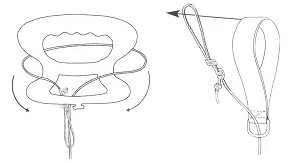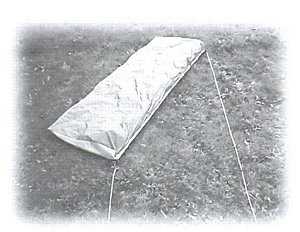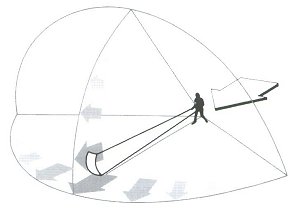
Some of these hints & tips are kite specific (foil power kites) but the majority apply to all kites

Some of these hints & tips are
kite specific (foil power kites) but the majority apply to all kites
| Attaching the lines to the controls | Most Dyneema
or Spectra line sets come ready to fly on a winder of some sort and are
pre-sleeved with all ends pre-looped. If your lines are not ready
prepared, ensure that they are the same length and that all four ends are
sleeved. Make the loops as shown on the right, taking care that they are
the same size.
Straps and handles are the most widely used control types. Attach them to the lines as shown. |
  |
| Attaching the lines to the kite | Form a sliding loop (larks head knot) and attach to relevant position on the kite. On the Flexifoil Super 10 this is the ends of the spar. |  |
| Launching | Select a suitable flying site - see the 'where we fly' section for more info. Foil power kites only fly when they are the right way up (vent above the spar pocket) and fully inflated by the wind. Make sure the wind is coming from behind you, towards the kite! |  |
| Assisted launching | This is by far the easiest method of launching your kite. Get someone to hold the kite up, gripping it lightly by the spar. Allow the kite to inflate as the vent is pointed into the wind. Pull the lines tight and signal to the person to release the kite. Walk back a little to assist the kite gain altitude and away she'll go! |  |
| Solo launching | This method of
launching can be tricky at best but your only choice if you've not got any
people around! Lay the kite (the right way up) at an angle to the wind. As soon as the kite is pulled straight into the wind it will inflate and take off - this is the plan anyway! getting the canopy to inflate can be tricky - it's best to inflate it first by holding it yourself to make sure all the creases from it being in its carry bag are out and not stopping air flow. You shouldn't drag your kite along the ground but you may need to move a few paces to help it. |
 |
| The wind 'window' | With the wind coming from behind you, a kite will have its greatest pull and speed directly in front of you. This place is called the centre of the wind window. The further you fly it to either side or the top, the less pull and speed you will have. |  |